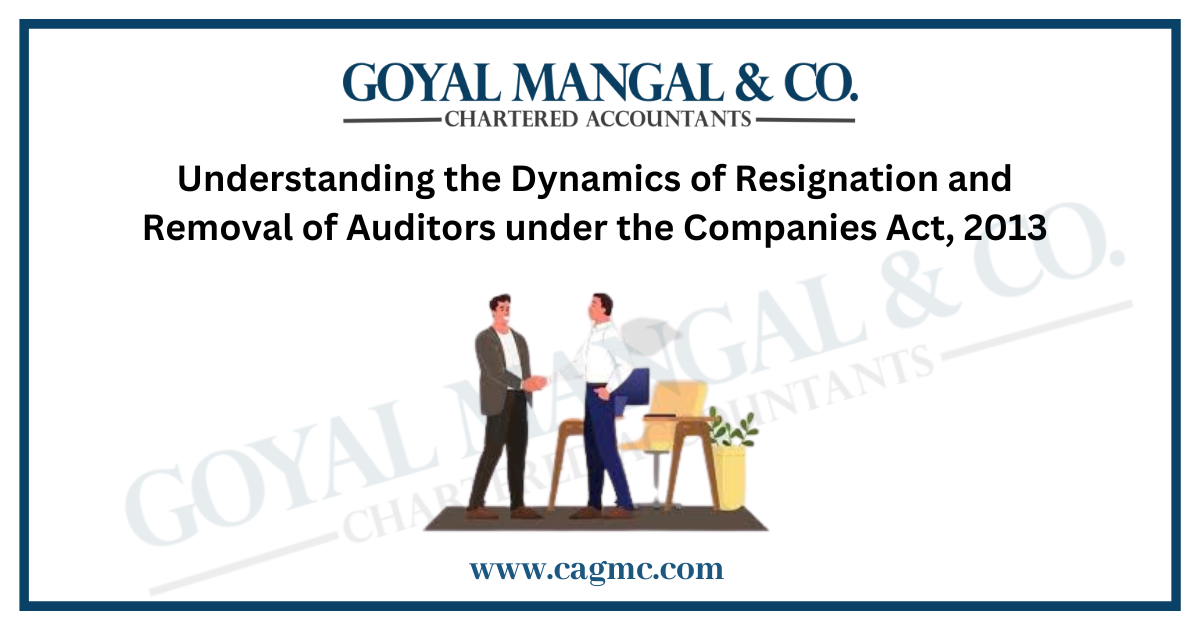
In the corporate world of governance, the role of auditors holds an immense position. Auditors play a vital role in upholding the transparency, accountability, and accuracy of a company’s financial reporting. However, sometimes there is a circumstance arises, where auditors either choose to resign or need to be removed from their positions before their term conclude. The Companies Act, 2013 provides a structured way to give resignations and removed auditors. In the current article, we are going to explore the procedure of resignation and removal of Auditors under the Company .
| Table of Content |
Meaning of Auditor
- An auditor is a professional who manages the financial framework of the company. Such as records, transactions, statements, and other relevant information of the company to make sure about their accuracy, completeness, and compliance with applicable laws and regulations. The Auditor’s primary objective is to provide an independent and objective assessment of an organization’s financial health and reporting.
- They play a significant role in managing the integrity and transparency of financial information. The Auditor’s help in the financial statements is a true and fair view of the company. They also assess what is the position of the company’s financial performance by legal requirements and accounting standards.
Types of Auditors
There are various types of auditors, including:
- External Auditors: They are also known as statutory auditors, These auditors are those, who are hired by the company for their financial statements and provide an opinion on their accuracy and compliance. External auditors play a key role in enhancing investor confidence by providing an unbiased assessment of the company’s financial reporting.
- Internal Auditors: They are the company’s employees, who are doing audits. They evaluate the internal controls, risk management processes, and operational efficiency of the company. The internal auditors help the company to identify their weaknesses and areas for enhancement.
- Government Auditors: Government auditors work for governmental agencies and audit public entities, government-funded projects, and government programs to ensure the proper use of public funds.
- Forensic Auditors: They investigate financial fraud, discrepancies, and financial misconduct. Forensic auditors often work closely with legal authorities to collect evidence for potential legal action.
- Tax Auditors: Tax auditors focus on reviewing an organization’s tax-related records and transactions to ensure compliance with tax laws and regulations.
What do you understand by Form ADT-3?
Form ADT-3 is the official form prescribed under the Companies (Audit and Auditors) Rules, 2014, for intimating the Registrar of Companies (RoC) about the resignation of an auditor. Here’s an outline of the information typically required in Form ADT-3 for the resignation of an auditor under the Companies Act, 2013:
- Section A: Details of the Company
- Corporate Identity Number (CIN) of the company.
- Global Location Number (GLN), if any.
- Name of the company.
- Address of the registered office.
- Email address of the company.
- Is the company listed as a company or not?
- Is the company a ‘Nidhi’ company or not?
- Whether the company is a ‘Government company’ or not.
- Section B: Details of Auditor Resigning
- Name of the auditor resigning.
- Membership Number/Incorporation Number of the auditor, if applicable.
- Permanent Account Number (PAN) of the auditor.
- Reason for auditor’s resignation.
- Date of appointment of the auditor.
- Date of resignation of the auditor.
- Details of any other engagements with the company.
- Section C: Details of New Auditor (if applicable)
- Name of the new auditor, if appointed.
- Membership Number/Incorporation Number of the new auditor, if applicable.
- Permanent Account Number (PAN) of the new auditor.
- Date of appointment of the new auditor, if applicable.
- Section D: Details of Consent of the Auditor Resigning
- Whether the auditor resigning has given consent to his/her appointment as auditor in writing.
- Whether the auditor’s resignation is due to any differences or disputes with the company, management, or Board of Directors.
- Attachments (if applicable)
- Copy of the auditor’s resignation letter.
- Proof of delivery of the resignation notice to the company.
Removal of the Auditor of the Company before the Expiry of Term
The removal of an auditor of a Company before the expiry of its term is governed by Section 140 of the Companies Act, 2013 in India. Here’s a step-by-step guide to the process:
- Special Notice: Members holding at least 1% of the total voting power or 100 members (whichever is lower) can issue a special notice to the company proposing the removal of the auditor of the Company.
- General Meeting: The company must call a general meeting to discuss and vote on the removal resolution. The company should provide reasonable notice to all members regarding the general meeting.
- Auditor’s Right to be Heard: The auditor being removed has the right to be heard during the general meeting. They can present their case and respond to any concerns raised.
- Passing the Resolution: The resolution for the removal of the auditor of the Company needs to be passed by a simple majority of the members present and voting at the general meeting.
- Approval by Central Government (CG): In case the resolution is passed, then the company is liable to send a copy of that resolution to the CG within 30 days of passing it.
- CG’s Decision: The Central Government will examine the resolution and may either confirm the removal or disallow it. In case, CG confirms the removal, then the auditor will be removed from the date of the resolution passed by the company.
- Filing with Registrar of Companies (RoC): At the time CG confirms the removal, the company must file a notice of removal of auditor with the RoC within 30 days of receiving the CG’s confirmation.
Procedure for Resignation and Removal of Auditor under Companies Act, 2013
Here’s a more detailed procedure for the removal and resignation by an auditor under the Companies Act, 2013:
Resignation by Auditor under the Companies Act:
- Notice to the Company: The auditor who wishes to resign must send a written notice of resignation to the company’s board of directors.
- Notice to the Registrar of Companies (RoC): The company, within 30 days of receiving the auditor’s resignation notice, must file a copy of the auditor’s resignation letter with the RoC.
- Reasons for Resignation: In the auditor’s resignation letter, there must be reasons mentioned of it.
- Auditor’s Statement (Optional): In case, auditors think any situation requires to be communicated to the creditors or members of the company. Then they will send a statement to the company
- Special Resolution (if required): In case the auditor’s resignation results in a casual vacancy, then the company must hold a meeting within 3 months of the resignation to appoint a new auditor.
Removal of Auditor:
- Special Notice: Members of the company holding at least 1% of the total voting power or 100 members (whichever is lower) can issue a special notice to the company proposing the removal of the auditor.
- Resolution and Opportunity to be Heard: The company must call a general meeting to discuss and vote on the removal resolution. The auditor has the right to be heard at the meeting.
- Approval by Central Government (CG): If the removal resolution is passed by the company, it must be submitted to the CG within 30 days of passing the resolution.
- CG’s Decision: The CG has the authority to examine the resolution for removal. They can either confirm the removal or cancel it based on their assessment.
- Notice to RoC: If the CG confirms the removal, the company must inform the RoC about the removal within 30 days of the CG’s confirmation.
Takeaway
The above article has shown the resignation and removal of auditors, which are not a simple process to do. It can impact a company’s reputation, investor’s confidence, and whole goodwill. Companies must approach these transitions with care, as per the requirement of legal structure for ensuring smooth handovers, and communicating transparently with stakeholders. The Auditors walked away die to their personal reasons or where their removal is required for the company. It is a set-up of the Companies Act provisions that will help in due diligence. There is mandatory to provide proper notifications, hearings, and approvals to protect the party’s interests.


